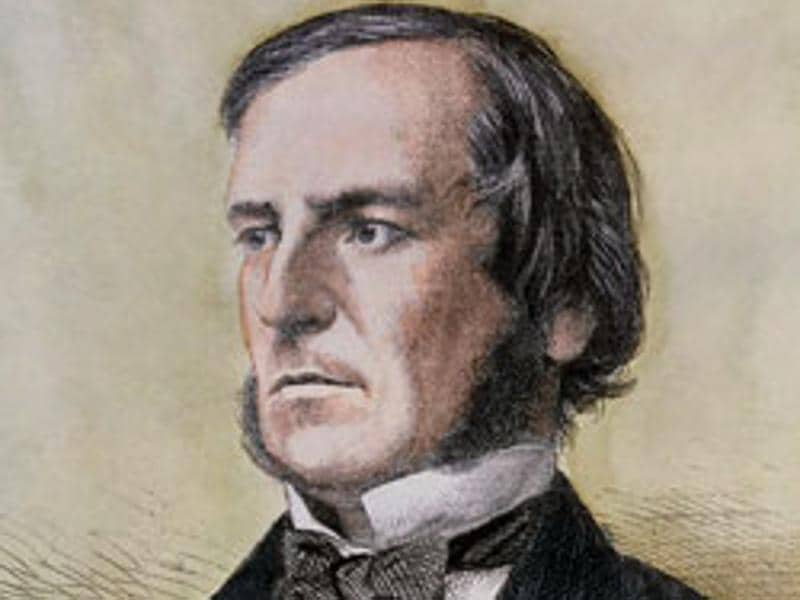He is one of the pioneers of contemporary mathematical logic: Who is George Boole?
He developed the 'language' of logic and tried to obtain a tool that draws conclusions according to the 'laws of thought' by giving logic an algebraic form of operation.

(1815-1864) English logician and mathematician. He is one of the pioneers of modern mathematical logic. He developed the "language" of logic, known as "Boolean Algebra", and tried to obtain a tool that draws conclusions according to the "laws of thought" by giving logic an algebraic form of operation.
George Boole (2 November 1815 – 8 December 1864) was a largely self-taught English mathematician, philosopher, and logician, most of whose short career was spent as the first professor of mathematics at Queen's College, Cork in Ireland. He worked in the fields of differential equations and algebraic logic, and is best known as the author of The Laws of Thought (1854) which contains Boolean algebra. Boolean logic is credited with laying the foundations for the Information Age.
He was born in Lincoln, England, and died in Cork, Ireland. He came from a poor family. His father was a shoemaker who made optical devices in his spare time and was devoted to mathematics. George went to primary school and only briefly to trade school. After that, he continued his education on his own, with the help of his father in mathematics. He learned Latin from a librarian in Lincoln and, by his own efforts, Greek, French, and German. At the age of twelve, he translated a poem by Horatius from Latin into English. There was a great controversy over this poem, which was published in a local newspaper. Some argued that the child could not do this translation, while others argued that the translation was inadequate. In contrast, Boole pursued his self-directed Latin and Greek studies with greater passion. He thought about becoming a priest for a while but gave up.
At the age of fifteen, he had to take care of his family. For this reason, he took on the duty of a primary school teacher. He taught during the day and continued his education at night. At the age of twenty, he founded his own private school. When he realized the importance of educating his students in the field of mathematics, he felt the need to deal with the subject more deeply. Despite his not very advanced knowledge of mathematics, he set out to study the masterpieces of Laplace, Lagrange, and Newton directly on his own. He began to publish the products of these works in the Cambridge Mathematical Journal in 1840.
He received a medal in 1844 for his work on operators. In his writings, he defended De Morgan against Hamilton's attacks and became friends with this mathematician in the 1848s. During these years he published The Mathematical Analysis of Logic. In 1849 he applied for a professorship of mathematics at the newly opened Queen's College in Cork. Although he was a primary school teacher, he was appointed to this position. In 1854 he wrote his masterpiece, The Laws of Thought. The following year, the famous mountaineer married Sir George Everest's niece. He continued his publications in various journals and wrote textbooks. He was elected a Fellow of the Royal Society in 1857. In 1864, he was caught in the rain to catch a lesson. He contracted pneumonia after class in wet clothes and died shortly thereafter.
The invention of Boolean invariants can be directly attributed to Lagrange. The most important source of influence that can be shown on his great contribution to the mathematical symbolism of logic can be shown as William Hamilton's attempt to humiliate Augustus De Morgan's criticism. This conflict intrigued Boole, who opposed the view of Hamilton, who was a philosopher, not a mathematician (not to be confused with the Irish mathematician William Rowan Hamilton), that mathematics could contribute nothing to logic. This is how he came to the view that logic found its basis in mathematics, not metaphysics. His work is, in a sense, an attempt to show how this happens, and how logic can be constructed as a symbolic structure based on axioms. With this work, he was turning an idea into a reality that both Leibniz and De Morgan were unable to achieve.
Boole's main contribution was to identify an analogy between logical and algebraic operations, and, based on this, successfully applied algebraic-mathematical methods to logic, for the first time in history.
In his system, which he called "Symbolic algebra theory," Boolean used two basic symbols. These are "1" and "0". In terms of the logic of classes, the first characterizes "Everything" and the second "Nothing". These are "universal" and "empty" classes. Other logically possible classes fall between these two. In this case, if any class is symbolized by the sign "x", the opposite class of this class will also be "l-x". In this way, this class-based logic becomes operational by using algebraic operations such as addition and subtraction.
Boole laid out the system outlined in his first book in great detail in his more comprehensive work, Laws of Thought, which he published in 1854. Here he took the view that the commonality between ordinary algebra and his own "calculus of classes" should be sought in a "higher logic" that includes "laws of thought".
